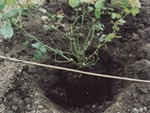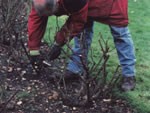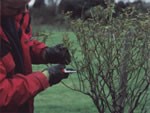Planting Advice
Roses look wonderful, smell terrific, are easy to grow and hardy, which means they can be left outdoors and flower year after year. Give them lots to eat and drink, a bit of love and appreciation and you’ve cracked it! There are hundreds of cultivars and colours to choose from,so the first step is deciding where to plant them in your garden
Choosing a Site
Roses will grow in almost any type of well-drained, reasonably fertile soil.
Choose a position that gets full sun, or at least half the day in the sun, and which is sheltered from strong winds but away from trees or large shrubs. If you are replacing old roses with new,remove as much of the old soil as possible and replace with soil that has not grown roses before.(The old soil will grow any other plants.)
Planting
PREPERATION & PLANTING TIME: 30 MINS
Container-grown roses can be planted year round into ordinary soil,provided it is not excessively dry, waterlogged or frozen.Plant bare-root roses (not in pots) only between October and early April.
 Dig a hole large enough to cover all the roots-about a spade’s depth-and loosen the soil around the hole with a fork. Improve the backfill soil by mixing in organic matter (garden compost, manure or proprietary rose and shrub compost) for good root growth.
Dig a hole large enough to cover all the roots-about a spade’s depth-and loosen the soil around the hole with a fork. Improve the backfill soil by mixing in organic matter (garden compost, manure or proprietary rose and shrub compost) for good root growth.
 Place the rose in the centre of the hole,carefully teasing out the roots of container plants and ensuring the roots of bare-root plants are well spread out.Lay a small cane across the planting hole to ensure that the graft union (swelling) is at,or slightly below,soil level.If no graft union is visible,plant at the same level as it was in the pot.
Place the rose in the centre of the hole,carefully teasing out the roots of container plants and ensuring the roots of bare-root plants are well spread out.Lay a small cane across the planting hole to ensure that the graft union (swelling) is at,or slightly below,soil level.If no graft union is visible,plant at the same level as it was in the pot.

Half fill the hole with soil,gently tread it in and add a little water. Replace the rest of the soil,tread it down firmly, then water.
Roses like to have space and air,so correct spacing will help ensure optimum growth.
Check the label or catalogue for recommendations.
Pruning
 Pruning promotes healthy flowers and should be undertaken in early spring. Wearing a tough pair of gardening gloves, first cut out any diseased, damaged, dead,weak or crossiing stems using sharp secateurs. Then, using secateurs or a pruning saw, make sloping cuts, just above an outward-facing bud, as follows:
Pruning promotes healthy flowers and should be undertaken in early spring. Wearing a tough pair of gardening gloves, first cut out any diseased, damaged, dead,weak or crossiing stems using sharp secateurs. Then, using secateurs or a pruning saw, make sloping cuts, just above an outward-facing bud, as follows:
 ESTABLISHED BUSH ROSES: On Hybrid tea (large flowered) roses,shorten last year’s strong shoots to four to six buds and weaker shoots to two to three buds.With Floribunda (cluster-flowered) roses shorten strong shoots back to leave 30cm growth and less vigorous ones more severely. Trim patio or miniature roses back to 10cm of the previous season’s growth. Trim all bush roses back after they finish flowering in november to stop wind-rock.
ESTABLISHED BUSH ROSES: On Hybrid tea (large flowered) roses,shorten last year’s strong shoots to four to six buds and weaker shoots to two to three buds.With Floribunda (cluster-flowered) roses shorten strong shoots back to leave 30cm growth and less vigorous ones more severely. Trim patio or miniature roses back to 10cm of the previous season’s growth. Trim all bush roses back after they finish flowering in november to stop wind-rock.
 BARE ROOT BUSH ROSES: When planting bare-root bush roses between October and March give plants an additional pruning (even though they look pruned). Cut back to around 8cm from ground level, which looks savage, but it will encourage the roots to grow and produce a stronger plant in the long term.
BARE ROOT BUSH ROSES: When planting bare-root bush roses between October and March give plants an additional pruning (even though they look pruned). Cut back to around 8cm from ground level, which looks savage, but it will encourage the roots to grow and produce a stronger plant in the long term.
CLIMBING/RAMBLING ROSES: Tie in strong sideshoots to their supports,then reduce their length by a third,shortening any sideshoots to two or three buds.
If growing climbing roses against a wall or fence, train them in September/October to grow horizontally (fan out). Stretch wires out along the wall/fence attached to vine eyes/nails,and bend the rose over,attaching it to the wire with string or raffia. The wires should be spaced at 60cm intervals starting above soil level. After a time,vertical stems will be thrown up from the trained stems. Use the strongest verticals arising from the base and/or the middle of the plant to train along higher wires to create another tier if required. Prune the remaining vertical stems to 1cm from the horizontal stem during September/October. In this way you will avoid an unsightly tall plant with a few flowers at the top and nothing below.
True ramblers flower only once each season and immediatly after flowering cut out flowered stems to ground level,tying in new ones.
See also www.rhs.org.uk.
LOOKING AFTER YOUR ROSES
FEEDING: A well-fed rose is a healthy rose,so regularly feed your plants;
Clay soil: add a rose fertiliser in March (after pruning) and once the first flush of flowers is over (usually late-June/July).
Sandy or chalky soil: Give roses a small handful of rose fertiliser each month from March to the end of July.
Loamy soil: roses will benefit from three or four feeds between March and the end of july.
Containers: use a slow-release fertiliser,and liquid feed from mid-July until September. Apply a graular fertiliser each spring and replace the top few inches of compost every other year with fresh.
WATERING: Although roses will tolerate a dry soil, they thrive in a moist, well drained soil. In dry weather, provide an occasional good soaking-watering little and often is not advisable. Watering in the morning or keeping leaves dry helps reduce incidence of disease.
PESTS & DISEASES: Much has been written on keeping roses fre from pests and diseases, but with good husbandry (proper feeding and watering) and choosing healthy rose cultivars (seek advice from rose specialists/garden centre/nusery staff, they can be avoided.If diseases appear,spray with a proprietary fungicide and prune out any badly affected stems. If pests (aphids) are troublesome,try wiping them off or use a proprietary brand of insecticide.(Ask garden centre/nursery staff for advice.)
MAINTENANCE: Snip of the dead headsa of finished flowers weekly to promote regrowth.
A shoot with light green leaves,green stems and a few thorns coming from the base of the plant could be a sucker. Do not cut it off-pull it off as deep as you can (with good gloves). If it is coming from underground, dig the soil away and pull it off.
Mulch around the base of rose plants in spring with garden compost,leaf mould or well rotted manure to keep moisture in the ground,smother weeds and improve the soil.
Rake up any dead leaves around your rose in winter to prevent infection from disease.
By following these guidelines,you can have roses that flower for up to five months of the year with the minimum of attention.
Happy rose growing!
Rose Types
There are thousands of different roses available and, increasingly, modern varieties are being bred for ease of growth, free flowering and pest and disease resistance. Decide which type you want to grow from the list below,then visit your garden centre or nursery to see what is on sale.
Alternatively,if you wish to buy a specific variety, visit: www.roselocator.com or www.roseuk.com for information on Find That Rose.
Hybrid Tea and Floribunda roses – average 75-120cm high,plant singly or in groups,can be underplanted with ground cover,perennial or bedding plants.
Patio and miniature roses – average 45cm high,ideal for low hedging,containers or rockeries.
Shrub/English roses– bushy,low-maintenance roses: plant singly or in groups in borders together with other shrubs and herbaceous perennials. Many are good for hedging.
Climbing/rambling roses – good for covering walls, fences or growing over arches,pillars and pergolas,and some will grow into hedges or trees: they have long shoots producing large clusters of flowers.
Groundcover roses – ideal for ground cover, banks or growing in accessible areas, these low-growing and spreading roses are also suitable for pots.
Standard roses – tall-stemmed roses can be eye catching centre-pieces in borders or in large pots.
GOOD COMPANIONS
The following plants are ideal companions for roses: alchemillas, alliums, anaphalis, anemones, campanulas, clematis, fennel, foxgloves, hardy geraniums, heathers, herbs, hollyhocks, lamiums, lavenders, lilies, marigolds, pulmonarias, tulips, verbascums
